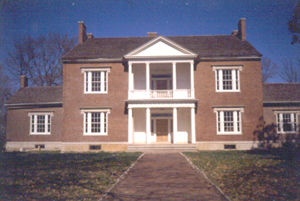
Hamilton Place
The antebellum plantation estate of Hamilton Place at Ashwood, Maury County, is a rare and exquisitely crafted example of the Palladian style of architecture. It was built from 1829 to 1831 by Lucius Junius Polk (1802-1870), one of the five sons of Colonel William Polk of North Carolina who each relocated to Maury County to establish large cotton plantations. The 1,400-acre plantation occupied a quadrant of the 5,648-acre “Rattle and Snap” tract acquired by Colonel Polk after the Revolution. Lucius Polk became one of the wealthiest planters in Maury County. He served in the state Senate in 1831 and was adjutant-general for the state from 1851 to 1853.
The house was begun in 1829 and completed two years later by crews sent out from North Carolina. Lucius named it Hamilton Place after his recently deceased brother, Alexander Hamilton Polk. The earliest and best detailed of the Polk mansions at Ashwood, the house embodies elements copied from high-style precedents. The design of the front was adapted from Palladio’s Villa Pisano for the Montagnardas, and an interior arcade is taken from Brunelleschi’s design for the hospital in Florence, Italy. The floor plan is loosely based on that of the White House, where Lucius Polk married Andrew Jackson’s niece, Mary Ann Eastin, in a ceremony in 1832. Polk’s large fortune was devastated by the Civil War, but Hamilton Place remained in the family until the 1970s.



